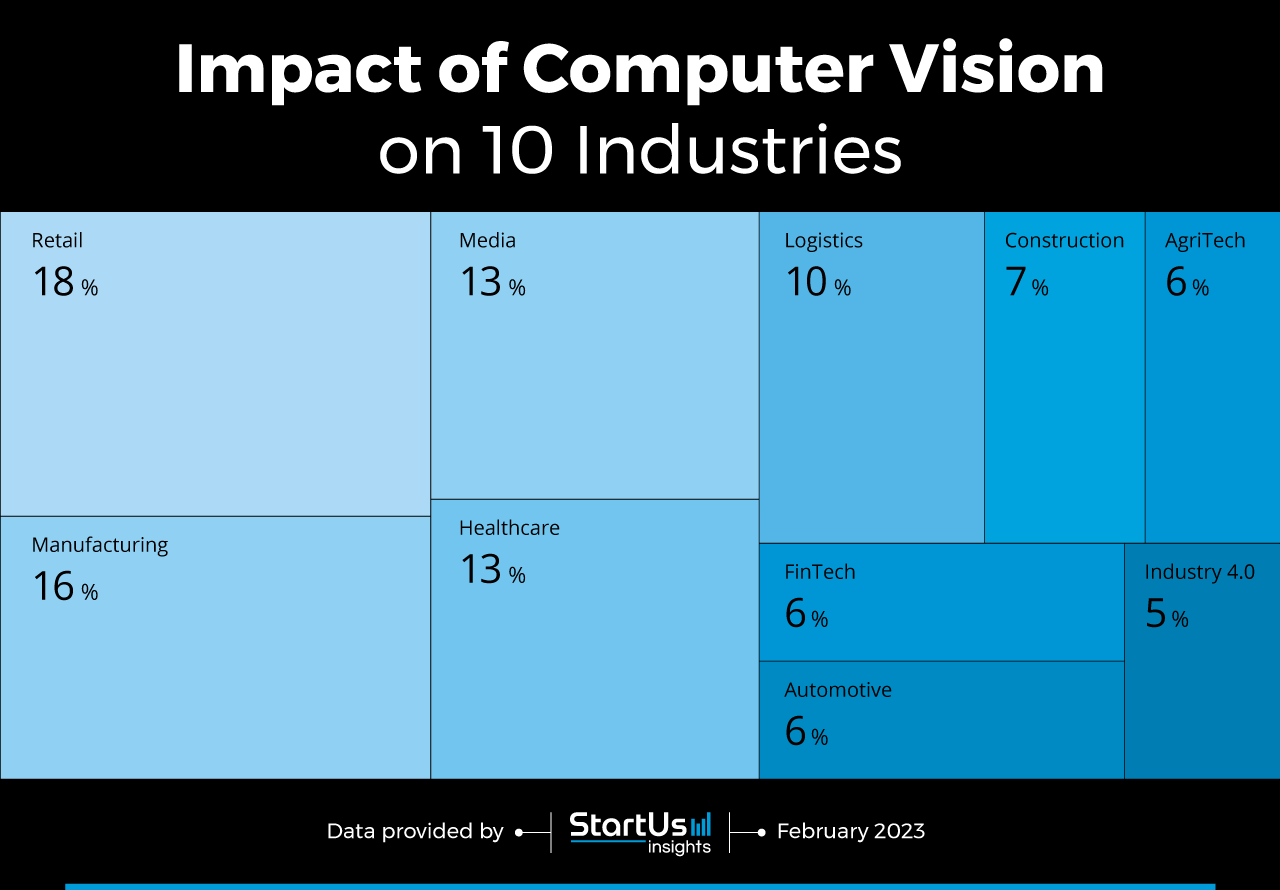Analyzing images and videos using computer vision provides insights into various aspects of daily activities. This includes worker monitoring in manufacturing plants and mining sites to wildlife and road traffic monitoring. We give you data-driven innovation insights based on our analysis of 2232 computer vision startups & technologies so that you do not miss out on emerging solutions that optimize operations. These solutions allow you to improve process efficiencies in real time. Read more to explore the impact of computer vision on 10 industries and how they advance your business.
Tree Map reveals the Top Computer Vision Applications in 10 Industries
The Tree Map below illustrates prominent computer vision examples across 10 industries in 2023 and 2024. Computer vision primarily finds applications for asset and worker monitoring across businesses. That is why the retail, manufacturing, logistics, construction, and automotive industries integrate computer vision-based solutions into operations. On the other hand, it improves image enrichment and content management for the media sector, whereas the healthcare industry utilizes computer vision to improve medical imaging and disease diagnosis.
Global Startup Heat Map covers 2232 Computer Vision Startups & Scaleups
The Global Startup Heat Map below highlights the global distribution of the 2232 exemplary startups & scaleups that we analyzed for this research. Created through the StartUs Insights Discovery Platform that covers 3 790 000+ startups & scaleups globally, the Heat Map reveals that the US has a high concentration of computer vision startups.
Below, you get to meet 10 out of these 2232 promising startups & scaleups as well as the solutions they develop. These 10 startups are hand-picked based on criteria such as founding year, location, funding raised, and more. Depending on your specific needs, your top picks might look entirely different.
Top Applications of Computer Vision across 10 Industries in 2023 & 2024
1. Retail
Retail companies leverage computer vision to enhance visibility into store operations to identify inefficiencies and suspicious activities. It also allows store managers to automate inventory tracking and improve store layouts. Consequently, startups develop computer vision-enabled apps that leverage out-of-the-box devices like smartphones, enabling cost-effecting integration.
Computer vision-powered checkout stations replace manual employees to provide self-checkout and touchless store interactions. Further, startups offer customer behavior analytics to understand their preferences and tailor product offerings to improve sales.
Grabit aids Fresh Food Monitoring
Grabit is a Spanish startup that develops a fresh food monitoring software solution. It uses computer vision to identify and monitor fruits, vegetables, meat, fish, and fresh produce. The software processes images and videos to count units, detect bad products, read expiration dates, and identify incorrect packaging, thus automating visual inspection. This allows retailers to streamline inventory management and improve sales and distribution efficiency.
2. Manufacturing
Computer vision-powered solutions analyze real-time images from production floors to identify defects. This enables continuous quality monitoring across factories, from automotive assembly lines to chemical manufacturing. As a result, such solutions allow manufacturers to ensure product consistency and improve customer satisfaction.
Further, increased visibility into production operations and workers enables manufacturers to mitigate production inefficiencies and downtimes. This aids lean manufacturing practices and allows them to enforce pandemic protective measures inside factories.
Invisible AI simplifies Worker Tracking
US-based startup Invisible AI tracks workers using computer vision. The startup’s AI-enabled cameras monitor worker body postures and movements to provide real-time feedback. It improves worker safety and ensures the correct and timely execution of different processes, eliminating errors in manufacturing processes. This also reduces scrap and rework costs while saving significant work hours.
3. Media
Media companies use computer vision to tag metadata, such as agency photos and online retail listings, for image enrichment. It also enables them to identify defects such as blurriness, nudity, and deep fakes. This, in turn, allows media businesses to mitigate the propagation of fake and offensive content, improving customer satisfaction and reach.
Some startups offer computer vision-based solutions to monitor social media content and identify trends and customer preferences in real time. Such platforms allow media companies to generate highly relevant content and improve content marketing efforts.
DeepBrand enables Content Aware Ads
Polish startup DeepBrand offers content-aware advertisements. The startup’s solution identifies and processes video inventories. It then analyzes the video assets to detect metadata like timestamps and object position. Further, the solution’s publisher panel allows media companies to browse contextual segments, select targeting criteria, and close orders fast. This, in turn, enables automated ad creation and minimizes ad delays.
4. Healthcare
Advances in computer vision aid medical imaging through enhanced image classification and object detection. That is why many startups leverage computer vision to assess tumor and cancer scans for early disease diagnosis. At the same time, surgical simulations using computer vision allow physician trainees to quickly develop clinical skills.
Such solutions offer real-time feedback to enhance surgical skills and analyze surgeries to detect hectic movements. Computer vision in healthcare enables timely disease detection, remote patient monitoring, and lean healthcare management.
Tensoreye advances Patient Monitoring
Tensoreye is a German startup that develops a computer vision-based patient monitoring platform. It detects patient positions and tracks patients 24×7 while providing hospital admins real-time visibility into hospital room statuses. Besides, the platform enables healthcare personnel to reduce bed falls and read patient diets. This improves bed management, optimizes discharge processes, and enhances internal communications.
5. Logistics
Continuous monitoring of logistics operations allows businesses to streamline processes. That is why startups offer computer vision-powered solutions that enable logistics companies to track assets, packages, and employees in real time. This, in turn, improves visibility into floor operations and enhances workplace safety.
At the same time, such solutions monitor the quality of packages to ensure product integrity and avoid cost-intensive returns. In warehouses, computer vision allows robots to navigate autonomously and improve material handling efficiency.
SearchNScore Solutions improves Warehouse Safety
SearchNScore Solutions is an Indian startup that builds DeepSight, a warehouse safety solution. The startup combines computer vision, 5G, and multi-access edge computing (MEC) to enable video analytics. DeepSight uses it to detect intrusions, fires, spills, and loitering, among others. This allows warehouses to ensure the safety of high-worth inventories while avoiding cost-intensive physical security.

6. Construction
Integration of computer vision-based solutions monitors equipment and worker movement to detect risky situations in construction areas. Startups thus leverage computer vision, along with advanced analytics, to offer real-time safety alerts to workers and security officers. It also advances construction automation by enabling autonomous robots for demolition, bricklaying, welding, and more.
Combined with drones, computer vision analyzes aerial imagery to create construction maps and track project progress, enabling remote construction monitoring. This allows construction companies to ensure optimum operations and improve customer satisfaction.
Eternal Robotics builds a Painting Robot
Eternal Robotics is a Singaporean startup that offers Myro, a painting robot for the construction sector. It leverages machine learning, computer vision, and mechatronics to automate painting. The robot features a movable part that contains a precision spray system and autonomous navigation. This allows businesses to speed up painting jobs and reduce associated costs.
7. AgriTech
Since the primary use case of computer vision is object identification, the agriculture sector leverages it to track animals and crop conditions. This, in turn, allows farms to improve animal welfare, prevent diseases, and analyze behaviors. In crop production, computer vision provides accurate yield prediction and field analysis.
Such solutions improve visibility into cultivation practices, maximizing and stabilizing crop yields. Further, growers and livestock managers use computer vision to leverage continuous and remote perimeter monitoring.
Fermatagro Technology simplifies Crop Monitoring
Israeli startup Fermatagro Technology offers Croptimus, a crop monitoring solution. The startup’s solution automatically detects pests and diseases 24×7 in greenhouses and indoor farms. This allows growers to reduce scouting costs and crop losses while maximizing yield and pest management efforts.
8. FinTech
The financial services industry deals with massive amounts of documents. By utilizing computer vision, FinTechs are able to accelerate document processing operations like customer verification by directly extracting information from digital images.
To aid this, startups offer out-of-the-box software platforms that process financial document images. They also facilitate property valuation and insurance claim verification. With computer vision, financial services are able to automate customer authentication through biometrics, improving security in financial transactions. Consequently, these applications of computer vision in FinTech reduce financial fraud.
Zentosa delivers Anti-Money Laundering (AML)
Zentosa is a Swedish startup that provides an AML solution. It leverages computer vision to label images and extracts information from invoices, receipts, commercial loan documents, and more. This labeled data allows financial services to process financial documents and develop fraud detection models to tackle money laundering.
9. Automotive
Automotive companies use computer vision to power autonomous driving systems and advanced driver assistance systems (ADAS). Advances in computer vision and data processing also improve the performance of autonomous systems, thereby enabling better navigation and accident prevention.
In manufacturing lines, computer vision simplifies assembly automation, quality control, and worker monitoring. Such solutions monitor all parts and components in assembly lines to detect surface defects and breakage. This allows vehicle manufacturers to avoid costly recalls and improve customer satisfaction.
Monk AI accelerates Visual Vehicle Inspection
Monk AI is a French startup that offers an AI-based visual vehicle inspection platform. It allows vehicle re-marketers to use images captured from smartphone cameras to identify frauds and damages. The platform enables them to accelerate vehicle condition reporting, standardize data, and receive instant inspection results.
10. Industry 4.0
Industrial automation deals with complex operations, forcing manufacturers to integrate cost-intensive robots and systems. Computer vision, on the other hand, utilizes camera modules already available on-site to provide visibility into operations and improve process automation.
For example, instead of replacing programmer-controlled robotic arms, manufacturers are able to use computer vision-powered tools to control them as needed for specific processes. It also allows site and plant managers to enable continuous quality monitoring and minimize costly defects that lead to product failures. This eliminates the scope of defective products reaching customers, saving time and capital for industries.
Ajna AI aids Worker Monitoring
Indian startup Ajna AI offers a worker monitoring solution. It uses computer vision to scan worker poses and track the movement of their joints. This allows floor managers to ensure the safety of workers by eliminating actions or poses that lead to sprains or injuries. Consequently, it allows them to improve worker availability and optimize production.
Discover All Computer Vision Startups
As computer vision algorithms require massive processing power and data storage capabilities, advances in high-performance computing (HPC) will improve their performance. This will accelerate the adoption of computer vision across industries from manufacturing and construction to emergency services and smart cities. Startups also aid this by offering solutions that leverage off-the-shelf components to reduce costs. Get in touch to identify specific computer vision startups & solutions that advance your business!











